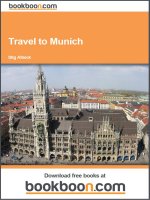Travel to Stockholm pot
Bạn đang xem bản rút gọn của tài liệu. Xem và tải ngay bản đầy đủ của tài liệu tại đây (6.01 MB, 70 trang )
Download free ebooks at bookboon.com
Download free ebooks at bookboon.com
Stockholm
© 2008 Stig Albeck & Ventus Publishing ApS
Translation: Frances østerfelt
All rights and copyright relating to the content of this
book are the property of Ventus Publishing ApS, and/or its
suppliers. Content from ths book, may not be reproduced
in any shape or form without prior written permission from
Ventus Publishing ApS.
Quoting this book is allowed when clear references are made,
in relation to reviews are allowed.
ISBN 978-87-7061-271-5
1st edition
Pictures and illustrations in this book are reproduced according
to agreement with the following copyright owners:
Stig Albeck.
The stated prices and opening hours are indicative and may
have be subject to change after this book was published.
Download free ebooks at bookboon.com
Stockholm
4
Kapiteloverskrift ONLIBRI
Download free ebooks at bookboon.com
Stockholm
5
A visit to Stockhom
www.stockholmtown.com
www.visitsweden.com
Queen of the Mälaren is another name for
Stockholm, the capital city of Sweden with its unique
location on the many islands between the Lake
Mälaren and the archipelago on the Baltic Sea.
Adventures in its beautiful nature are part of the
city’s trademark and everywhere one is convinced
that this was the perfect spot to put a large city.
But there is much more to Stockholm than the
surrounding nature. Here is something for everyone.
Gamla Stan is the city’s Old Town and here one can
wander through narrow and twisted streets of the
Middle Ages and never see a modern building. The
opposite is true in the modern business quarters that
stretch out from Sergel’s Square and offer a wealth
of shopping possibilities as well as cultural events
and restaurants.
The museums of Stockholm are a quite special.
One is more interesting than the next and they are
spread throughout the city. The gem of them all
must be the unique ship Vasa that sank on its
maiden voyage in 1628, has been restored and can
now be seen in its full glory.
Happy holiday!
A visit to Stockholm
Download free ebooks at bookboon.com
Stockholm
6
Historical outline
Stockholm was built on the strategically important
trading route between the waters of Lake Mäleren
and the open waters of the Baltic. On the region’s
highlands goods of iron, copper and leather were
transshipped.
Its position as a transshipping harbor grew in
importance and it became necessary to fortify the
center where there were but a few inhabitants. In
1250, Birger Jarl built a fortress in what is now the
center of Stockholm and in 1252 he bestowed the
city with trading privileges.
Thanks to Baltic trade, which was lead by the Hanse
Union, Stockholm grew rapidly. In only 100 years,
Stockholm became Sweden’s largest city and absolutely
dominated the region. The previously important
settlements like Birka were abandoned for good.
Stockholm was first mentioned in the Chronicles of
Erik, thought to have been written in 1322-1332.
Stockholm was referred to as the city between the
bridges, a description the visitor readily understands.
The original Stockholm city, which is now the Old
Town, grew quickly and soon became overpopulated.
There were frequent fires but houses in the city’s
narrow streets were soon rebuilt and can be seen
even today. Major constructions of the time included
the Great Church (Storkyrkan) and Three Crowns
(Tre Kronor) Tower. In the 1300-1400’s the
population in the small area of the city outgrew its
bounds and led to development of the areas
Norrmalm and Södermalm.
In 1388 Stockholm came under siege by the queen
of the Danish Union, Margrethe I, and the city fell in
1398. Union between Denmark, Norway and
Sweden was a reality and the queen had a larger wall
built around the city. At the close of the 15th
century, Stockholm’s population was 5,000 – a
considerable size considering the conditions of the
time.
In 1471 Sweden vanquished the army of the Danish
Union in Norrmalm. The country broke from
Denmark-Norway but re-entered the union in
1497-1502 under King Hans. King Christian II re-
conquered Stockholm after King Hans and in 1520
had 83 Swedish leaders executed on the Great
Square during the so-called Stockholm Blood Bath.
In 1523 Gustav Vasa was crowned Sweden’s king
and the period under Danish rule was brought to an
end. Stockholm became the leading city of the kingdom
and the king’s city of residence. But it wasn’t until 1614
that the city became the official capital.
In the 17th century Sweden became the super
power of the Baltic and Stockholm became its royal,
military and administrative center. This led to a
boom in the population.
The Thirty Years’ War in 1618-1648 meant
prosperity for Stockholm. Trade grew and many
palaces were built, including Riddarholmen.
Throughout the century people flocked to the city
and many new neighborhoods were built. Around
1700 the population was approximately 45,000.
There were large residential areas, palaces and the
royal castle.
The 1700’s was a period of stagnation for the city,
which from around the Baltic met growing
competition, including Tsar Peter the Great’s
building of St. Petersburg in 1703. In 1711,
Stockholm was ravaged by the Plague, which
significantly reduced its population.
The century, however, brought with it scientific and
cultural growth to the capital and at its ending,
under King Gustav III, the city continued the
expansion that began in the 1600’s.
The 19th century meant even more prosperity for
Stockholm. The city was rebuilt, many of the older
areas were replaced by newer and more modern
Historical outline
Download free ebooks at bookboon.com
Please click the advert
Stockholm
7
neighborhoods. Many public buildings and
institutions, such as the hospital, were built.
Industrialization also made its mark on the city.
From 1860 railroads were built and from 1877 there
was a network of trolleys. The city’s industries grew
and with them came neighborhoods, like
Sundbyberg, for the workers as well as for the
wealthy, like Djursholm. In 1900 Stockholm’s
population was 300,000.
Throughout the greater part of the 20th century,
Stockholm was on the rise. In 1912, the city was the
scene for the Olympic Games, which put the
Swedish capital on the map of the world.
During both of the world wars, Sweden remained
neutral, thereby avoiding destruction. The country
saw relatively greater growth than many of the other
countries that were directly involved in the conflicts.
Growth and general urbanization meant an increase
in Stockholm’s population from around 500,000 in
1930 to one million in 1960.
In the 1960’s large areas in Stockholm were torn
down to give way for modern construction. Sergel’s
Square is the best example; the central square was
built in the old Jugend style neighborhood Klara.
Modernization has been a serious topic of debate
since then but has been instrumental in giving
Stockholm a metropolitan atmosphere with the
large, modern and at times monumental
constructions in the center of the city.
In the latest decades there has been much done to
continually develop the city for tourists and to make
Stockholm a leader in business. For tourists, the
waterways, as at its founding in the 13th century,
form the basis for many activities and the city’s
beautiful location is also unforgettable.
Historical outline
Download free ebooks at bookboon.com
Stockholm
8
Tour 1: Stockholm
1. Stockholm’s City Museum
(Stadsmuseum)
Ryssgården, Slussen
www.stadsmuseum.stockholm.se
Subway: Slussen
Stockholm’s City Museum is located in Södra
Stadshuset from the 17th century; and relates the
history of the city and its inhabitants from the city’s
founding up to the present time. A visit is a journey
back in time from a small medieval harbor city to an
international metropolis.
Stockholm’s City Museum was founded in 1937 and
opened its doors to the public five years later.
2. The Katarina Elevator
(Katarinahissen)
Subway: Slussen
The Katarina Elevator is one of Stockholm’s more
curious attractions. The 38-meter-high construction
starts at the middle of the Salt Lake Line’s
(Saltsjöbanens) platform, continues at street level and
ends at the top, from which there is a wonderful view
over the Old Town and Stockholm’s Stream, where
there are always many boats.
The elevator was built in 1883 to facilitate the
journey to the hills of Södermalm. At the beginning
you had to pay 5 øre to go up and 3 øre to come
down. In 1933 the elevator was dismantled and in
1935 the present elevator was installed.
Tour 1: Stockholm
Download free ebooks at bookboon.com
Stockholm
9
3. Old Town (Gamla Stan)
Subway: Gamla Stan
Gamla Stan is the Swedish name for Stockholm’s old
town. For many centuries, Gamla Stan together with
the buildings on the neighboring island
Riddarholmen made up the Swedish capital.
Old Town itself lies on the island Stadsholmen and
its center is an exciting medieval neighborhood that
invites to exploration of the narrow streets and paths.
Earlier there was a wall around the center of Old
Town, lying at the present streets Österlånggatan
and Vesterlånggatan. When the last of the defenses
were demolished in the 17th century, the
perpendicular streets around Little New Street (Lilla
Nygatan) and Greater New Street (Stora Nygatan)
were created.
4. Iron Square (Järntorget)
Subway: Gamla Stan
With its Parisian atmosphere, this charming square,
Iron Square (Järntorget), is one of the Old Town’s
most evocative sites. There are even Parisian cafés,
where one can sit and observe the many passers by.
5. The German Church (Tyska Kyrkan)
Svartmangatan 16
www.st-gertrud.se
Subway: Gamla Stan
Stockholm’s German church, also known as
St.Gertrud’s Church, was built by the Hanse Union
in 1570. The building was originally a meeting place
for the Hanse. Later remodeling created the
religious function. An annex built in 1642
transformed the building to what it is today.
A fire in 1878 destroyed the church’s tower. The
present tower, 96 meters high, was then built and is
the Old Town’s highest building.
The church contains a pulpit from 1660 made of
marble and alabaster.
Tour 1: Stockholm
Download free ebooks at bookboon.com
Stockholm
10
6. The Great Square (Stortorget)
Subway: Gamle Stan
The Great Square is the midpoint of the medieval
Old Town (Gamla Stan); and the well on the square
was previously the geographic center of Sweden! It
was from this point that distances from the capital
city were measured. Today it is measured from
Gustav Adolf’s Square.
The beautiful and charming Great Square has been
the scene of many executions in the past. The first
was in 1280; and the most famous was “The
Stockholm Blood Bath” in 1520 when the Danish
King Christian II executed 83 noblemen and
Swedish leaders.
Today more peaceful events take place on the square.
In season, there is outdoors serving so that you can
sit and enjoy the beautiful houses.
6a. the stock Exchange (Börshuset) /
Nobel Museum
www.nobelmuseum.se
The largest and most distinct building on the Great
Square is the old stock exchange that now serves as
the Nobel Museum. Its placement was central in
the old city; and the city’s town hall was also located
here, in a row of medieval buildings.
Tour 1: Stockholm
Download free ebooks at bookboon.com
Please click the advert
Stockholm
11
Construction of the Stock Exchange was inspired by
French classicism with rococo elements in its facade.
Inside is a beautiful assembly hall, The Great
Exchange Hall (Stora Börssalen). It was in this room
that the Swedish stock exchange was located.
Since 2001 the building has housed the Nobel
Museum, which provides information about one of
the events for which Stockholm is famous –
awarding of the Nobel Prizes.
6b. The Cannon ball (Kanonkuglen)
A smaller but unique attraction at the Great Square
is the cannon ball in the wall of the house on the
corner of the Great Square and Cobbler Street
(Skomakargatan). History tells that it is from Gustav
Vasa’s siege of the city in 1521 but there is no
historical evidence for this. It is also said that the
furniture dealer Grevesmühl had a new house built
on the site in 1795 and that he put the cannon ball
there where it had been in the previous building.
7. The Great Church (Storkyrkan)
Slottsbacken
www.stockholmsdomkyrkoforsamling.se
Subway: Gamla Stan
The Great Church, also known as St. Nicholas
Church, in Stockholm was built on the island
Stadsholmen’s highest plateau. The first church was
built in the 13th century, the remains of which can
still be seen in the northern walls of the tower.
Tour 1: Stockholm
© Deloitte & Touche LLP and affiliated entities.
360°
thinking
.
Discover the truth at www.deloitte.ca/careers
© Deloitte & Touche LLP and affiliated entities.
360°
thinking
.
Discover the truth at www.deloitte.ca/careers
© Deloitte & Touche LLP and affiliated entities.
360°
thinking
.
Discover the truth at www.deloitte.ca/careers
© Deloitte & Touche LLP and affiliated entities.
360°
thinking
.
Discover the truth at www.deloitte.ca/careers
Download free ebooks at bookboon.com
Stockholm
12
It is said that the first church burned down and that
a new one was consecrated in 1306. Later in the 14th
century some chapels were added; but the largest
addition was made in the 15th century.
In the period 1736-1742 the facade was transformed
from the medieval ”buddings” to the Baroque style
seen today. The reason for the change was that the
building should harmonize with the royal palace,
which was built just northeast of the church. The
church’s tower measures 66 meters in height.
The Great Church also served as the coronation
church. The first coronation was in 1336, when
Magnus Eriksson became the Swedish monarch.
This coronation, however, was thought to have
caused a strong desire for Norwegian independence,
and for this reason the coronations were stopped.
The next coronation in The Great Church was of
King Hans in 1497, who was union king of
Denmark, Norway and Sweden. The tradition
continued until the last coronation, in 1873, of King
Oscar II.
The church has also been the setting for several
weddings, including the marriage between the
Danish king-to-be Frederik IX and his queen Ingrid,
who was born a Swedish princess.
Inside, the church has in part been returned to its
medieval style; and among its attractions is the pulpit,
created in the 1680’s according to instructions by
Nicodemus Tessin the Younger.
8. Stockholm’s Castle
Slottsbacken 1
www.kungahuset.se/dekungligaslotten/kungli
gaslottet
Subway: Kungsträdgården
Stockholm’s Castle, also called the Royal Castle, is
the official residence for the Swedish royal family.
However, they actually live at Drottningholm Castle
on the island Ecker west of Stockholm.
Until a fire in 1697, the old castle Tre Kronor was
located here. The architect Nicodemus Tessin the
Younger drew a new castle, Stockholm Castle, on
Tre Kronor’s foundation. The castle was to be
grand – a Baroque palace with 600 rooms and many
large salons.
Construction was completed in 1754; and the royal
family could again move into the castle from their
temporary residence at the Wrangel Palace on
Riddarholmen.
Tour 1: Stockholm
Download free ebooks at bookboon.com
Please click the advert
Stockholm
13
With its 605 rooms, Stockholm Castle is one of the
largest in the world that is still the residence of a
monarch – at least officially. There are exciting
museums within the castle and many of the official
rooms and salons are open to the public.
8a. Representation Rooms
Slottsbacken 1
www.kungahuset.se/dekungligaslotten/kunglig
aslottet/slottet
The castle’s beautiful rooms for representative
functions are furnished in various styles, from
Baroque and Rococo to Gustavian neoclassicism.
Among the rooms that are open to the public
includes the Assembly Hall (Festvåningen) in which
the grand galla banquets are held. There is also
access to the Rikssalen, where the king previously
read his opening speech for the parliament
(Riksdagen) from his silver throne.
8b. The Royal Treasury (Skattkammaren)
Slottsbacken 1
www.kungahuset.se/dekungligaslotten/kungli
gaslottet/skattkammaren
The Royal Treasury has displayed Sweden’s regalia
since 1970. Gustav Vasa’s sword and Erik XIV’s
crown are among the objects on display.
Tour 1: Stockholm
Increase your impact with MSM Executive Education
For more information, visit www.msm.nl or contact us at +31 43 38 70 808
or via
the globally networked management school
For more information, visit www.msm.nl or contact us at +31 43 38 70 808 or via
For almost 60 years Maastricht School of Management has been enhancing the management capacity
of professionals and organizations around the world through state-of-the-art management education.
Our broad range of Open Enrollment Executive Programs offers you a unique interactive, stimulating and
multicultural learning experience.
Be prepared for tomorrow’s management challenges and apply today.
Executive Education-170x115-B2.indd 1 18-08-11 15:13
Download free ebooks at bookboon.com
Stockholm
14
8c. Gustav III’s Antique Museum
Lejonbacken
www.kungahuset.se/dekungligaslotten/kunglig
aslottet/gustaviiisantikmuseum
In the castle’s northeastern wing is Sweden’s oldest
art museum which opened in 1794. The collection
comprises purchases made by King Gustav III on
his journey to Italy in 1783-1784.
8d. The Royal Armory (Livrustkammaren)
Slottsbacken 3
www.livrustkammaren.lsh.se
In the basement of the castle one gets an intimate
knowledge of the history of the Swedish military and
the royal family. Among the many objects, there is
the king’s parade carriage, clothing, armor and
weapons. There is King Karl XII’s uniform and
King Gustav III’s mask for an opera masquerade in
1792.
The museum is the oldest in Sweden. It is from 1628,
when King Gustav II Adolf commanded that his
armor from a campaign in Poland should be stored
forever.
8e. Museum Tre Kronor
Norrbro
www.kungahuset.se/dekungligaslotten/kungli
gaslottet/museumtrekronor
Tre Kronor (Three Crowns) is the name of the
castle that burned down in 1697 and thus made
room for the present royal palace.
The museum is installed in the lowest level of the
castle’s north wing and was that part of the castle
that best survived the fire of 1697. It presents the
history of Tre Kronor from the first fortifications
to the castle that exists today. An interesting detail
is that the entrance to the museum is through a
five-meter thick wall that was part of the castle’s
defense in the 13th century.
9. The Finnish Church
Slottsbacken 2
www.svenskaChurchn.se/finskaforsamlingen
Subway: Kungsträdgården
This church is the religious meeting place for
Stockholm’s Finnish congregation. The church’s
official name is Fredrik’s Church, after the Swedish
king Fredrik I.
The building is from 1648-1653 and was known as
the Little Ball House (Lilla Bollhuset), until the
Finnish congregation bought the house and
converted it to a church in 1725. In the 20x10
meter large church, the altar piece is from 1734.
Tour 1: Stockholm
Download free ebooks at bookboon.com
Please click the advert
Stockholm
15
10. The Royal Mint
(Kungliga Myntkabinettet)
Slottsbacken 6
www.myntkabinettet.se
Subway: Kungsträdgården
The Royal Mint displays the history of money, banks
and medals; and within these themes there are many
exciting pictures, objects, etc.
Money’s history is an exciting topic for many; and its
history goes back 2,500 years. One of the highlights
is the archaeological findings from the Viking period.
11. The Knight’s House (Riddarhuset)
Riddarhustorget 10
www.riddarhuset.se
Subway: Gamla Stan
The Knight’s House was built according to Simon
de la Vallée’s drawings from 1641-1674, and is
considered to be one of Stockholm’s most beautiful
buildings. At the time of its construction, the most
significant influences were from France and
Holland, which can clearly be seen in the house.
The Knight’s House was and is a house for nobility.
In it was assembled that part of the parliament
composed of Swedish nobility, who formed a
separate part of the assembly until 1866.
Tour 1: Stockholm
Get “Bookboon’s Free Media Advice”
See the light!
The sooner you realize we are right,
the sooner your life will get better!
A bit over the top? Yes we know!
We are just that sure that we can make your
media activities more effective.
Download free ebooks at bookboon.com
Stockholm
16
Today, the designation “Knight’s House” implies the
building as well as the institution that comprises
Sweden’s nobility. Since 1869, noblemen have
assembled in the Knight’s House every third year.
12. Riddarholm Church
Birger Jarls Torg
Subway: Gamla Stan
Knight’s Island Church lies on the islet of
Riddarholmen, which is adjacent to the Old Town
(Gamla Stan). The church was built in 1280-1310 for
the Franciscan monastery that was located there. The
other monastic buildings were torn down in the 17th
century; after which time Riddarholm Church
continued as a parish church until 1807, when it
acquired the status as a cemetery and memorial church.
Since its construction many chapels have been
added to the main church building, including in
1632-1634 a chapel for King Gustav II Adolf. At
present the most beautiful grave chapel is for the
Bernadottes, built in 1858-1860. King Karl XII,
who conquered regions in western Russia, is among
those buried here. There are also many family crests
on display.
The tower and spire on the church were designed
after destruction of the previous one in 1835. The
spire itself, however, is a copy that was placed
during the church’s renovation in 1967-1970.
13. View from Knight’s Islet
(Riddarholmen)
Evert Taubes Terrace
Metro: Gamla Stan
From the western side of the small island
Riddarholmen is an amazing view to the City Hall
(Stadshuset), Södermalm and Kungsholmen.
It is from here that many photographs of the city
hall are taken; and there is a wonderful view of the
beautiful old boats that sail to Mälaren.
Tour 1: Stockholm
Download free ebooks at bookboon.com
Stockholm
17
14. Postal Museum
Lilla Nygatan 6
www.postmuseum.posten.se
Subway: Gamla Stan
The Swedish postal museum was founded in 1906
and included the history of the postal service as well
as of stamps.
The history of Swedish stamps is told from the very
first issue in 1855 as well as objects from the postal
service and an exciting collection of foreign stamps.
Tour 1: Stockholm
Download free ebooks at bookboon.com
Please click the advert
Stockholm
18
Tour 2: Stockholm
15. City Hall (Stadshuset)
Hantverkargatan 1
www.stockholm.se/stadshuset
Subway: T-centralen/Rådhuset
Stockholm’s city hall, beautifully located at Mälaren
Beach, is the city’s trademark and pictured on
practically all presentations of the Swedish capital.
The city hall was built in 1911-1923 according to
Ragnar Östberg’s design and is Sweden’s largest
national romantic construction. Inspired by the
Italian Renaissance, there are two gardens in the
building (Citizens’ garden, Borgargården, and the
Blue Hall, Blå Hallen). On the south side towards
the “Knight’s Fjord” (Riddarfjärden) a beautiful
arched passage run the entire length of the wing.
There are many beautiful rooms in the city hall,
including the Blue Room, which is the building’s
largest assembly hall. It is here where the Nobel
banquet takes place. In the hall is also the great
organ with its 10,000 pipes.
The city council meets in the council room
(Rådssalen). Notice the roof that is inspired by the
old Viking buildings.
In the Oval Room (Ovalen) the Tureholm
tapestries hang, which were woven in France in the
17th century.
Tour 2: Stockholm
GO T -THE-ENERGY-T O-LEAD.C OM
We believe that energy suppliers should be renewable, too. We are therefore looking for enthusiastic
new colleagues with plenty of ideas who want to join RWE in changing the world. Visit us online to find
out what we are offering and how we are working together to ensure the energy of the future.
Download free ebooks at bookboon.com
Stockholm
19
The Prince’s Gallery is the official receiving room,
which is beautifully furnished and looks out on to
the water.
In the Golden Salon, more than 18 million glass and
gold pieces were used, a very impressive installation.
Visitors can go up the 106-meter-high tower and get
a fantastic view over the city. Entrance to the tower
is through the arched corridor of the southern wing.
The tower’s peak was the last to be designed – the
Three Crowns (Tre Kronor), the Swedish national
crest, symbolizing that the City Hall is not just
Stockholm’s, but all of Sweden’s, pride.
Towards Mälaren lies City Hall Park
(Stadshusparken), with its lovely lawns and
sculptures, some in marble or bronze. To the south
in the direction of Riddarholmen is a 20-meter-high
column, with the rebel Engelbrekt Engelbrektsson
standing on its top.
To the east is the sarcophagi which was built for
Stockholm’s founder, Birger Jarl. But his earthly
remains were never moved from Varnhem as was
the plan. So the sarcophagi remains empty.
16. Stockholm’s Subway
Subway: Bl.a. T-Centralen.
Stockholm’s underground train, the Subway, is a
fantastic construction, which stands out from
subways in other countries while it was blasted out
of the granite underground. The stations lie deep
under street level and the effect of the rough stone
halls is impressive. Many of the central stations are
decorated with a milieu, colors or a theme from the
station’s location, such as the stations between the
Royal Gardens and Solna Center.
The first line in Stockholm’s subway was opened in
1950; and is Sweden’s only underground train. Since
its opening the network has been expanded; and
today there are three lines, each of which branches
out in the suburbs. In general, the stations were
built in three ways: (1) Mountain stations that were
blasted out of the mountain, (2) Concrete stations,
where the visible parts are of concrete and (3)
Aboveground stations. Today there are
approximately 100 stations, about half of which are
subterranean. The 38 mountain stations are the
most fascinating.
17. Santa Clara Church
Klara Östra Kyrkogata 7
www.stockholmsdomkyrkoforsamling.se
Tour 2: Stockholm
Download free ebooks at bookboon.com
Stockholm
20
Subway: T-Centralen
Construction of the centrally located Santa Clara
Church has a long history. Originally there was a
convent on the property that in 1286 was donated by
King Magnus Ladulås for the purpose. Three years
later, construction of the convent was complete
including its church. In 1527 the building was razed
in connection with the Reformation. Building
materials from this and other demolished convents
were used to reinforce the city’s defenses.
King Johan III instituted construction of a new
church where the old convent had been. It is
thought that building was started in 1572 and
completed in 1589. One year later, the tower was
embellished with copper.
Expansion of the church continued in the following
centuries, but was abruptly interrupted by a large fire
in 1751. Rebuilding of the destroyed parts was
started and two years later the church could again be
consecrated.
The last to be built was the tower. In 1768, drawings
were accepted but due to lack of funds, it was first
built in 1884-1886.
18. Sergel’s Square (Sergels Torg)
Subway: T-Centralen
Sergel’s Square is modern Stockholm’s central square,
named after the 18th century sculptor Johan Tobias
Sergel.
The square itself is at street level with a sunken
pedestrian level. To the east is the 37-meter-high
glass obelisk, the ”Crystal Vertical Accent”, which
was created in 1974 by Edvin Öhrström and placed
in a super ellipse-shaped fountain.
Around Sergel’s Square are some of Stockholm’s
most important shopping streets, including Queen
Street to the west. To the south is the Culture
House (Kulturhuset) and to the northeast is the
southernmost of the five skyscrapers,
Hötorgsskraporna, built in 1955-1966.
19. Queen Street (Drottninggaten)
Subway: T-Centralen
Drottninggatan is Stockholm’s always bustling
walking street, filled with shoppers or folk just
enjoying the sidewalk cafés in the summer season.
20. Strindberg Museum
Drottninggatan 85
www.strindbergsMuseum.se
Subway: Rådmansgatan
The writer August Strindberg lived here at
Drottninggatan 85 the last four years of his life (1908-
1912). He called this place The Blue Tower (Blå Tornet).
The house is now a museum for August Strindberg
and furnished on the whole with the original
inventory. Among the attractions is Strindberg’s
study, where the author’s writing utensils are
displayed.
Tour 2: Stockholm
Download free ebooks at bookboon.com
Please click the advert
Stockholm
21
21. Observatory Museum
Drottninggatan 120
www.observatoriet.kva.se
Subway: Rådmansgatan
At the top of Observatory Hill is Stockholm’s Old
Observatory (Gamla Observatorium). It was built
by the Royal Academy of Science in 1747-1753.
Besides its function as an observatory,
meteorological studies have been performed here
since 1756.
In the observatory’s Meridian Room, the precise
local time of Stockholm was established, until 1900
when Greenwich Mean Time was taken into use. In
1931 primary observations were moved to the
newly constructed facilities in Saltsjöbaden but the
old facilities are still used by amateur astronomers.
In 1991 the Observatory Museum was opened and
on special days there is general access for the public
for star gazing. The building’s history and highlights
from the observatory’s past are retold at the
museum. There are also alternating exhibits.
Tour 2: Stockholm
Contact us to hear more
Who is your target group?
And how can we reach them?
At Bookboon, you can segment the exact right
audience for your advertising campaign.
Our eBooks offer in-book advertising spot to reach
the right candidate.
Download free ebooks at bookboon.com
Stockholm
22
22. Stockholm’s City Library
Sveavägen 73/Odengatan 53
www.ssb.stockholm.se
Subway: Rådmansgatan/Odenplan
Stockholm’s main library opened in 1928, and
besides its collection of more than 700,000 books,
the building is also worth seeing. The reading room
in the central rotunda is particularly beautiful.
23. Gustaf Vasa Church
Odenplan
www.gustafvasa.nu
Subway: Odenplan
Gustaf Vasa Church lies in the center of what is
called Vasa Town, in Stockholm. It is impressive,
almost 60 meters high to the top of its dome, one
of the largest churches in Stockholm with seating
for 1,200.
The church’s floor plan is like a Greek cross and
the building itself is neo-Baroque, particularly
inspired by the Baroque churches in Italy. It was
consecrated in 1906.
Inside the visitor is met with a lovely sight. The
altar decoration was inspired by the Gesu Church in
Rome and created in 1725-1731 for the cathedral in
Uppsala. The painted dome and marble pulpit are
other attractions.
Tour 2: Stockholm
Download free ebooks at bookboon.com
Please click the advert
Stockholm
23
Tour 2: Stockholm
THE BEST MASTER
IN THE NETHERLANDS
Download free ebooks at bookboon.com
Stockholm
24
Tour 3: Stockholm
24. Svea Way (Sveavägen)
Subway: Rådmansgatan/Hötorget
Sveavägen is the largest street that runs from the
heart of Stockholm to the north. In the 18th century,
King Gustav III had plans to convert the street to a
boulevard with esplanades in a line from Stockholm
Castle to Haga Castle (which is today Haga Castle
ruins). Today Svea Way is a lively street with office
buildings and several oriental restaurants.
On February 28, 1986, Sweden’s Prime Minister
Olof Palme was assassinated on Svea Way where it
crosses Tunnel Street (Tunnelgatan). There is a
commemorative plaque marking the spot.
25. Adolf Fredrik’s Church
Holländargatan 16
www.adolffredrik.nu
Subway: Rådmansgatan/Hötorget
This parish church was built in 1768-1774, and
consecrated by the Swedish king and other
prominent persons. Since 1674, there was a wooden
chapel on the site, which was preserved during the
construction of the new church, by building around
the chapel so that it stood in the middle of the new
church room.
The church is primarily built in the classical style,
and crowned by a small chapel with lanterns on its
top. It is 54 meters high.
The church’s interior is not the original, as it
underwent major renovation in 1893-1895. The
altarpiece, which represents the Resurrection, was
created by Johan Tobias Sergel, after whom the
neighboring Sergel’s Square was named.
26. King Street (Kungsgatan)
Subway: Hötorget
King Street is the main traffic artery through the
city. Notice the two imposing tower-like office
buildings on either side of the street where it
crosses Malmskillnadsgatan.
Tour 3: Stockholm
Download free ebooks at bookboon.com
Stockholm
25
27. Concert Hall
Hötorget
www.konserthuset.se
Subway: Hötorget
The concert hall is the leading playhouse for
orchestrated music in Stockholm and is the home of
the city’s philharmonic orchestra.
But the concert hall is best known as the venue for the
annual awarding of the Nobel Prizes (with the exception
of the Peace Prize, which is awarded in Oslo).
The building was opened in 1926 and is one of the
best examples of neoclassicism of the 1920’s.
28. Museum of the Mediterranean
(Medelhavsmuseum)
Fredsgatan
www.medelhavsMuseum.se
Subway: Kungsträdgården
This museum contains historical collections from
the Middle East and Mediterranean regions.
The museum was founded in 1954 on the basis of
several older collections. It opened in its present
building in 1982. Among its attractions is the
world’s finest collection of terracotta figures from
Cyprus, Egyptian mummies, Islamic works of art
and much more.
29. The Parliament (Riksdagen)
Riksgatan 3A
www.riksdagen.se
Subway: Kungsträdgården
Sweden’s House of Parliament was built in 1894-
1905 to house the country’s two chambers. In 1971,
Sweden became a unicameral system; and the
building was rebuilt to accommodate the change.
The building is in the neo-Baroque style and is in
two parts: the east and west wings. There are guided
tours through the building.
30. Museum of the Middle Ages
(Medeltidsmuseum)
Strömparterren, Norrbro
www.medeltidsMuseum.stockholm.se
Subway: Kungsträdgården
Stockholm’s subterranean medieval museum is built
around ruins from the city’s early history; and
shows the city’s growth from its founding and up
through the Middle Ages.
Tour 3: Stockholm









